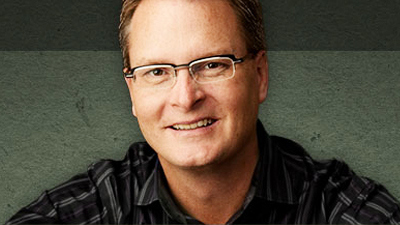Lewis Center Director Lovett Weems interviews Adam Hamilton to glean insights for other churches in the Church of the Resurrection’s success.
The Rev. Adam Hamilton is one of the outstanding mainline church leaders in America. At age 26 he started the United Methodist Church of the Resurrection (COR) in Leawood, Kansas, a suburb of Kansas City, Missouri. He has led COR in becoming a dynamic congregation of over 14,000 members. In 2000, he was named by PBS’s Religion and Ethics Newsweekly as one of the ten religious leaders to watch in the new century.
1. Why has Church of the Resurrection (COR) grown so dramatically when so many other congregations planted in areas of comparable population growth and resources have failed?
From the outset, we sought to understand what Jesus was about in his ministry and what we as the “body of Christ” were to be about as we formed a new church. Bible study made clear our aim was to reach non-religious and nominally religious people. This seemed the focus of Jesus’ own ministry. In our community, where many people have undergraduate and graduate degrees, we recognized these would be thinking people who had opted out of church. Once clear about whom to reach and why, we built strategies to accomplish this mission. We evaluated the effectiveness of all our tactics in terms of reaching these people. When people came to the church, they found hospitality, passion, and relevance. Each sermon aimed to speak to the intellect and the heart and came with an invitation to do something concrete in response to what was heard. We sought to do ministry with excellence, with a “high touch” approach to first-time visitor follow-up and pastoral care.
As we grew, we came to points where we had outgrown our facilities, staffing, organizational structure, and ministry model. At such junctures, many churches become exhausted or resistant to change. They stop doing what is necessary to increase capacity. When COR’s sanctuary reached capacity, we started another worship service. When that reached capacity, some staff and lay leaders believed it would be “too hard” to add a third service. Members might no longer “know everyone’s names.” But we focused on our mission, overcame opposition, and added a third service. Eventually, we grew to have seven worship services before moving into a larger building and returning to five. Had we stopped at two, we would be a congregation of 350 rather than 7,000 to 8,000 worshipers each weekend.
2. How has your role as pastor changed as the congregation grew from a small group meeting in a funeral home to thousands in worship each weekend?
I do less and less hands-on ministry. In the beginning, I made all of the hospital calls. Today, we have five full-time pastors doing pastoral care. I make two or three hospital calls a month, not because the church needs me to, but so I can stay connected with people in need. I used to attend every committee meeting. Now, I attend one monthly Staff-Parish Committee meeting and Church Council six times per year. I have only a few pastoral counseling appointments each week, but I spend four to five hours in meetings with different staff. I also spend more time planning worship and preparing sermons – an average of 25 hours per week. I focus on preaching, casting the vision, setting the overall tone of our church, raising funds, and representing COR in the church community and world.
3. What do you see as the key roles for pastors wherever they serve?
Aside from pastors developing healthy spiritual lives of their own, preaching is the most important thing. Pastors also must help their congregations develop a Christ-centered vision of their future. Finally, pastoring is all about building relationships, loving people, and encouraging them. My first bishop, W.T. Handy, would say in his wonderful southern drawl, “the key to ministry is simple — preach the Word and love the people.”
4. What are the most important lessons from COR’s experience for older churches with fewer members and resources?
Many churches suffer from low self-esteem. Like people, they need to believe there is a future for them. They need hope. They often need to rediscover their mission and their Gospel mandate. They need pastors who love them and help them remember their calling.
I believe any size church benefits from being clear about its mission; developing strategies and tactics to fulfill that mission; pursuing ministry with passion and relevance; and offering quality sermons.
5. What’s ahead for COR?
We are launching a satellite ministry twenty minutes from our main campus. At the outset, there will be two services – one contemporary, one traditional. Everything will be live except the sermon. Forty weeks of the year, the sermon will be either live via satellite or pre-recorded at our Saturday night worship. Two campus pastors will preach the other weeks. We believe we could have 1,000 worshippers weekly at the satellite within a year or two. If successful, we would like to try this in an urban setting, and a rural setting, and then make the sermons and worship plans available to other churches.
Some of your readers will find this idea unpalatable at first glance. I certainly did. Then I worshiped at a video venue in Atlanta and found it a surprisingly positive experience. Back at COR, I began noticing how many people watched the video screens as I preached. Churches unable to afford a pastor or whose pastor was on leave began requesting videos of our sermons. They have been used in small congregations, in prisons, and at a Salvation Army men’s center. Twice in the last month, lifelong church members in their fifties and sixties told me they had visited video venue services and actually liked them.
A second major emphasis in the coming year will be community outreach. In recent years, our church has focused on developing small groups, strengthening our ministries, and creating capacity for ministry. We focused less on the community outside our church. We were doing great mission work in the urban core, but a lousy job of serving people without a church home who are in our own backyard. So we are going to put significant energy into sending our ministries outside the walls of the church.
Related Resources
- Organizing a Missional COMMUNITY Doug Powe and Henry H. Knight III
- Leading Unafraid Adam Hamilton
- The New Welcome Video Tool Kit
- Take the Next Step: Reaching More People, Younger People, More Diverse People






